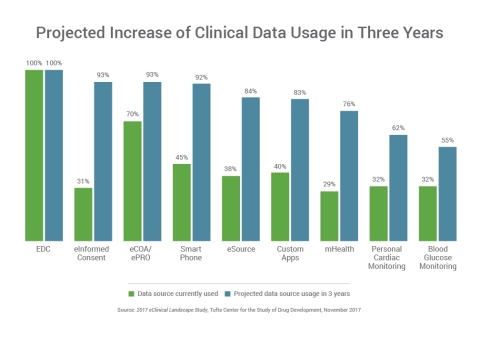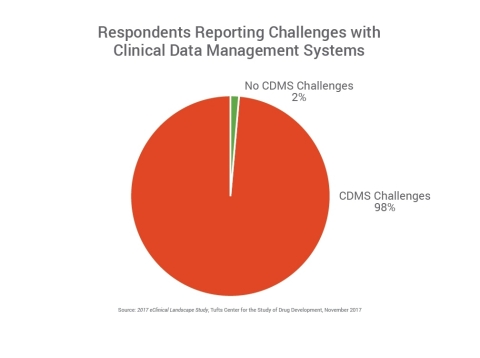BOSTON & PLEASANTON, Calif.--(BUSINESS WIRE)--The volume and diversity of data sources used in clinical trials are expected to increase significantly over the next three years, according to new research from Tufts Center for the Study of Drug Development. In the second report from the 2017 eClinical Landscape Study, one of the largest, most in-depth surveys of clinical data management professionals, 97% of companies say they will increase use of at least one clinical data source to make faster, more accurate decisions during trials. However, 98% of respondents currently report challenges with their clinical data management systems, indicating that companies will need to be better prepared to collect and analyze the growing volume of real-world patient data available from a variety of sources.
“Clinical trial complexity is challenging scientific, operating, and technology solution domains,” said Ken Getz, research associate professor and director at the Tufts Center for the Study of Drug Development. “At the same time that clinical teams are managing traditional data from case report forms and local and central labs, they are being forced to step out of their comfort zone to manage, integrate, and analyze data from more diverse and less compatible sources, including smart phone and wearable devices, real-world evidence, and social media.”
Volume and Diversity of Clinical Data Sources Expected to Increase
Life sciences companies use an average of four data sources in clinical trials today. In three years, the number of data sources utilized is projected to increase to six, with 70% of companies planning to use a new data source that they are not leveraging today.
The survey also showed very significant changes in the range of clinical information organizations plan to use in the next three years. Nearly all (93%) respondents expect to use eInformed consent data (up 62 percentage points from today). A majority of companies also plan to use mHealth and smart phone data (each increasing 47 percentage points) and eSource data (increasing 46 percentage points).
Significant differences were also observed when comparing company type and size. CROs report they plan to use more data sources than sponsors. Similarly, those with the highest trial volumes (greater than 15 trials per year) say they will use more sources of clinical data within the next three years compared to those with lower trial volumes.
Companies Manage a Limited Volume and Variety of Data Today
While the industry expects to leverage a greater range of patient data in clinical trials, today companies are primarily managing electronic case report form (eCRF) data in their primary EDC system. In three years, 93% of respondents aim to use electronic patient reported outcomes (ePRO) and electronic clinical outcomes assessment (eCOA) as sources, but today that data makes up only 4% of the total data managed in EDC. Similarly, 76% plan to use mHealth data as a source, but only 10% are currently managing it in their primary EDC application and it represents just 0.3% of the total data managed in EDC.
The majority of data in EDC (78%) is eCRF, which only provides one dimension of data into a patient’s overall health. Moving forward, to collect and analyze a higher volume and variety of electronic data beyond just eCRF, there will be a greater need for EDC applications to better access and centralize clinical information.
“Clinical trials are more sophisticated and include a growing amount of patient data from many diverse sources. So trials are increasingly complex endeavors,” said Scott Fisher, Ph.D., executive director of emerging therapies at Intrexon Corporation. “The overall volume of data we collect is rising dramatically as we take advantage of mHealth to accumulate billions of data points per patient. Having a modern EDC system to bring this data together will be key to making accurate, real-time decisions and accelerating our clinical trials.”
Challenges with Clinical Data Management Systems
When asked about the single biggest challenge with their clinical data management systems today, most respondents cite cycle time (30%), including time from protocol completion to first patient, first visit (FPFV) and time from last patient, last visit (LPLV) to database lock. The time it takes from LPLV to database lock is approximately 36 days which, despite efforts to shorten, is even longer than it was more than 15 years ago (36 days vs. 33 days).1
Cost was the second most prevalent challenge among respondents (29%), followed by the number of clinical systems (18%). The amount of companies that cite ‘number of systems’ as their single biggest challenge rises to 28% as trial volume increases. Respondents with high trial volumes have seven applications versus four for those with low trial volume. As companies manage more trials, the ability to unify applications and processes will become increasingly important in improving trial efficiency.
Specific to EDC, loading data into the primary EDC application is an issue for the majority (77%) of sponsors and CROs, and 66% of those point to EDC system or integration issues as the main cause. Data loading challenges risk becoming a larger problem as companies utilize more data from more sources over the next three years.
“Life sciences companies want to collect more data from more sources, but are experiencing challenges managing the data they have now,” said Richard Young, vice president of Veeva Vault EDC. “There is a significant opportunity for organizations to create a complete picture of their trials as new data points are generated or recorded so they can drive better decisions.”
The 2017 eClinical Landscape Study: Assessing Data Management Practices, Performance, and Challenges from Tufts Center for the Study of Drug Development, sponsored by Veeva Systems (NYSE: VEEV), reviews the state of data management in life sciences with an in-depth look at the insights and opinions of clinical data management professionals at more than 250 companies, including sponsors and CROs, with an average of 17 years of experience in clinical data management. Download the full report at veeva.com/EDCSurvey.
To learn more about the latest findings, register for the webinar, New Tufts Research: EDC Trends, Insights, and Opportunities, featuring Ken Getz, research associate professor and director at the Tufts Center for the Study of Drug Development, and Richard Young, vice president of Veeva Vault EDC, on Thursday, November 16 at 11:00 a.m. ET.
Research Highlights
2017 eClinical Landscape Study:
Usage of Data Sources, Management Applications, and Their Challenges
The 2017 eClinical Landscape Study examines the state of clinical data management in the life sciences industry. The goal of the research is to understand current clinical data management practices and assess the performance and challenges of electronic data capture (EDC) systems.
One of the largest, most in-depth clinical data management studies to date, this research captures the insights and opinions of 250 clinical data management professionals, including sponsors and CROs with an average of 17 years of clinical data management experience.
Clinical Data Source Utilization
- 97% of companies say they will increase use of at least one clinical data source to make faster, more accurate decisions during trials, with 70% planning to use a new data source that they aren’t currently using.
- Companies use an average of four data sources in clinical trials today and are projected to use an average of six data sources in three years.
- eInformed consent data is expected to have the biggest increase in three years, tripling from 31% usage to 93%.
- Use of smart phone and mHealth data will rise by 47 percentage points, and the use of eSource data will grow from 38% to 84%, more than doubling current usage.
- CROs are set to outpace sponsors in how frequently all data sources are used, including eSource data (97% to 81% usage) and mHealth data (90% to 73%).
- Companies with higher clinical trial volume are expected to use a wider variety of data sources more frequently than those managing fewer clinical trials.
Data Sources in EDC Applications
- The most commonly reported data type in EDC is electronic case report form (eCRF) data (100%), followed by local lab and quality of life (QoL) data at 60% each. 10% of companies load mobile health data into their EDC application today.
- 93% of respondents aim to use electronic patient reported outcomes (ePRO) and electronic clinical outcomes assessment (eCOA) data, and 76% plan to use mHealth data in three years.
- While companies have a variety of data types in their EDC, respondents say the largest proportion of the data in EDC is eCRF data (78% of total data managed). All other data types are each estimated at 5% or less of the total volume of data in the EDC, including ePRO data (3%), eCOA data (1%), and mobile health data (0.3%).
Challenges with Clinical Data Management Systems
- Nearly all (98%) clinical data management professionals report challenges with their clinical data management systems.
- The biggest single challenge respondents cite is cycle time (30%), including time from protocol completion to first patient, first visit (FPFV) and time from last patient, last visit (LPLV) to database lock. Cycle times are the biggest challenge for CROs (32%) and companies with a high trial volume (31%).
- 29% of respondents said their biggest challenge is costs in clinical R&D, including sponsors (31%), companies using industry-leading EDC applications (30%), and low trial volume companies (41%).
- The number of systems in clinical R&D is the single biggest challenge for 18% of respondents, including 28% of high trial volume companies.
- The more trials a company manages the more clinical trial applications they use (seven applications versus four for low trial volume).
- Loading data into the primary EDC application is a challenge for the majority (77%) of sponsors and CROs, and 66% of those point to EDC system or integration issues as the main cause.
About the Tufts Center for the Study of Drug Development
The Tufts Center for the Study of Drug Development at Tufts University provides strategic information to help drug developers, regulators, and policy makers improve the quality and efficiency of pharmaceutical development, review, and utilization. Tufts CSDD, based in Boston, conducts a wide range of in-depth analyses on pharmaceutical issues and hosts symposia, workshops, and public forums, and publishes Tufts CSDD Impact Reports, a bi-monthly newsletter providing analysis and insight into critical drug development issues. For more information, visit csdd.tufts.edu.
About Veeva Systems
Veeva Systems Inc. is a leader in cloud-based software for the global life sciences industry. Committed to innovation, product excellence, and customer success, Veeva has more than 550 customers, ranging from the world's largest pharmaceutical companies to emerging biotechs. Veeva is headquartered in the San Francisco Bay Area, with offices in Europe, Asia, and Latin America. For more information, visit veeva.com.
1 Lamberti MJ, Kush R, Kubick W, Henderson C, Hinkson B, Kamenju P, Getz KA. An examination of eClinical technology usage and CDISC standards adoption. Therapeutic Innovation & Regulatory Science. 2015.



